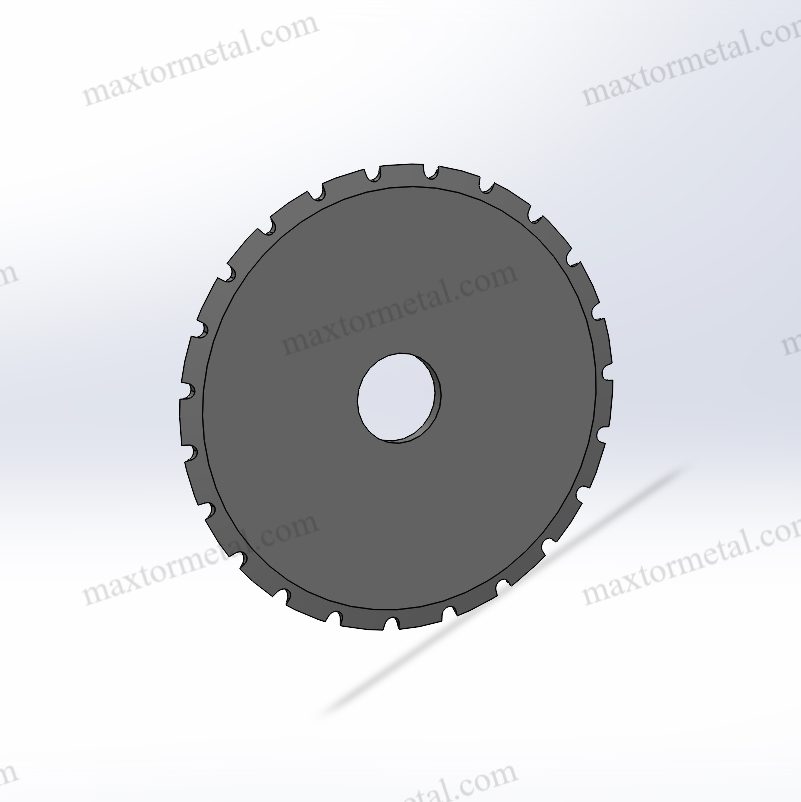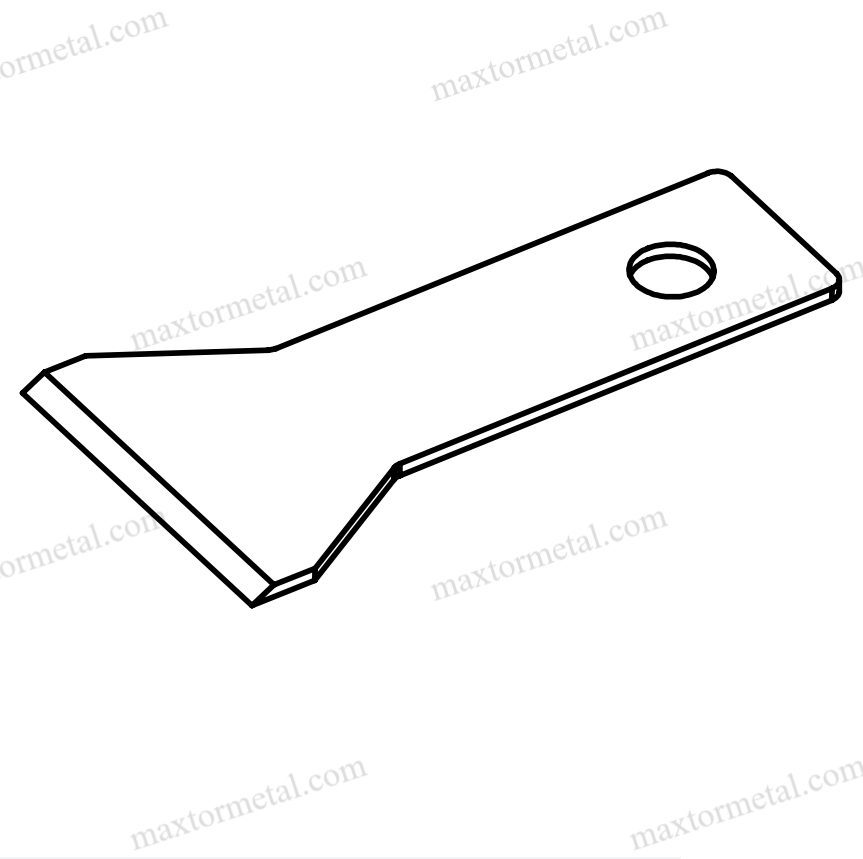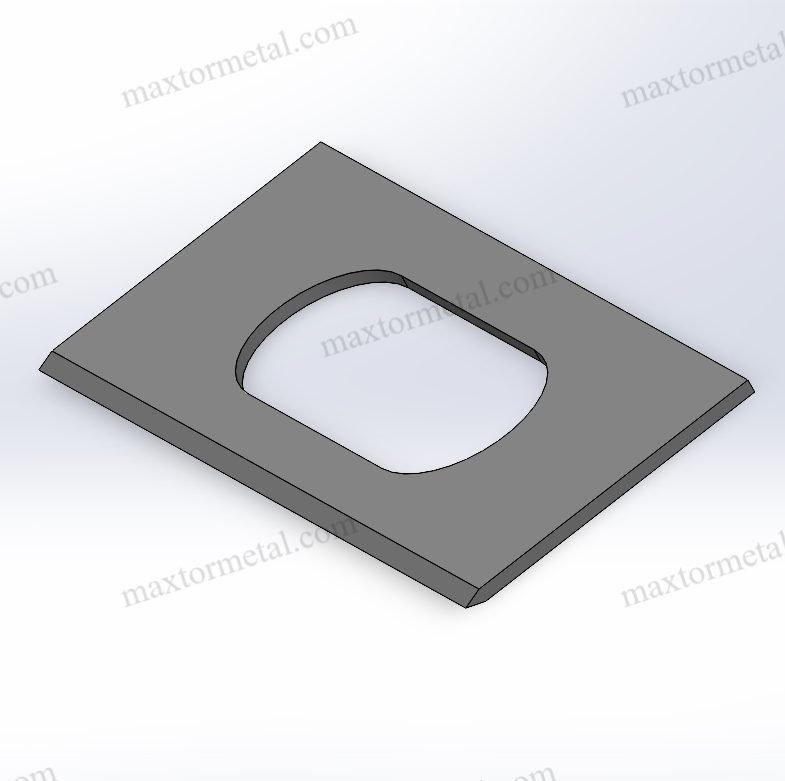Industrielle Klingentoleranz spielt eine entscheidende Rolle bei der Bestimmung der Effizienz, Haltbarkeit und Wirtschaftlichkeit von Fertigungsprozessen. Die Wahl der falschen Toleranz kann zu schlechter Schneidleistung, übermäßigem Maschinenverschleiß und erhöhten Betriebskosten führen. Studien deuten darauf hin, dass falsche Sägeblatttoleranzen aufgrund von Fehlausrichtung und erhöhtem Verschleiß zu bis zu 30% höheren Wartungskosten führen können.
Bei Nanjing Metal, Wir haben 18 Jahre Erfahrung in der Entwicklung und Herstellung Präzisions-Industrieklingen. Unsere Expertise ermöglicht es uns, kundenspezifische Industrieklingen die Toleranzstandards für Klingen mit Kosteneffizienz in Einklang bringen. In diesem Artikel untersuchen wir die Grundlagen der industriellen Klingentoleranz, ihre Auswirkungen auf Leistung und Fertigung und wie man die optimale Toleranz für verschiedene Anwendungen wählt.

1. Was ist die Toleranz industrieller Klingen?
Definition der Blatttoleranz
Die Toleranz industrieller Klingen bezeichnet den zulässigen Abweichungsbereich der Klingenabmessungen, einschließlich Dicke, Länge, Breite und Kantenschärfe. Diese Toleranzen stellen sicher, dass die Spezifikationen der Maschinenklingen den Betriebsanforderungen entsprechen, ohne die Leistung zu beeinträchtigen.
Die Rolle der Toleranz bei der Leistung von Rotorblättern
Eine genau definierte Fertigungstoleranz der Klinge stellt sicher, dass:
- Die Klingen passen präzise in die Schneidemaschinen, wodurch eine Fehlausrichtung verhindert und Vibrationen reduziert werden.
- Der Schneidvorgang bleibt konstant, wodurch das Risiko von Materialfehlern verringert wird.
- Produktionsausfallzeiten werden durch weniger Anpassungen und Austausch minimiert.
Gängige Toleranzbereiche für Klingen
Verschiedene Branchen erfordern unterschiedliche Präzisionsniveaus. Nachfolgend finden Sie eine allgemeine Richtlinie für Klingentoleranzstandards:
| Klingentyp | Dickentoleranz (mm) | Längentoleranz (mm) | Kantentoleranz (mm) |
| Standard Industrie | ±0,05 | ±0,10 | ±0,02 |
| Präzisionsschneiden | ±0,02 | ±0,05 | ±0,01 |
| Medizin/Luftfahrt | ±0,01 | ±0,03 | ±0,005 |
Die Wahl der geeigneten Toleranz ist für den Ausgleich von entscheidender Bedeutung Klingenleistung und Produktionseffizienz.
2. Warum die Wahl der richtigen Klingentoleranz wichtig ist
Die Auswirkungen enger und weiter Toleranzen
Viele Hersteller gehen davon aus, dass engere Sägeblatttoleranzen immer zu einer besseren Leistung führen. Obwohl hohe Präzision in manchen Anwendungen entscheidend ist, können zu enge Toleranzen die Herstellungskosten erhöhen, ohne wesentliche Vorteile zu bringen. Zu geringe Toleranzen können hingegen zu Leistungsschwankungen und einer Fehlausrichtung der Sägeblätter führen. Die richtige Balance zu finden, ist entscheidend.
Engere Toleranzen: Wann sind sie hilfreich?
Engere Toleranzen (z. B. ±0,01 mm) sind entscheidend, wenn:
- Klingen müssen mit anderen Präzisionskomponenten interagieren (z. B. chirurgischen Skalpellen und Messern für die Luft- und Raumfahrt).
- Bei Hochgeschwindigkeitsschneidprozessen ist Konsistenz erforderlich, beispielsweise beim hochpräzisen Metallstanzen.
- Das zu schneidende Material ist hochempfindlich (z. B. ultradünne Filme oder empfindliche Verbundwerkstoffe).
Das Erreichen extrem enger Toleranzen erfordert jedoch fortschrittliches CNC-Schleifen, Lasermessung und zusätzliche Qualitätskontrollschritte, die alle die Kosten erhöhen.
Lockerere Toleranzen: Wann sind sie akzeptabel?
Eine geringere Klingentoleranz (z. B. ±0,05 mm oder ±0,10 mm) ist akzeptabel, wenn:
- Der Schneidevorgang erfordert keine extreme Präzision (z. B. Holzbearbeitung, Schneiden großer Lebensmittelmengen).
- Maschinen lassen geringfügige Abweichungen zu, ohne dass die Leistung beeinträchtigt wird.
- Die Materialeigenschaften werden weniger durch Toleranzschwankungen beeinflusst (z. B. Pappe, Gummi, Kunststoffe).
Durch die Wahl einer angemessenen Toleranz anstelle einer unnötig strengen können Unternehmen die Herstellungskosten um bis zu senken 20-30% bei gleichzeitiger Beibehaltung der effektiven Schneidleistung.
Fallstudie: Klingen für die Lebensmittelverarbeitung
Ein Lebensmittelverpackungsunternehmen gab zunächst eine Toleranz von ±0,01 mm für seine Schneidklingen an, in der Annahme, dies würde die Schnittgenauigkeit verbessern. Die Realität sah jedoch so aus:
- Die Produktionskosten stiegen um 30%, da engere Toleranzen eine fortschrittliche Präzisionsbearbeitung erforderten.
- Aufgrund zusätzlicher Qualitätskontroll- und Kalibrierungsprozesse verdoppelten sich die Vorlaufzeiten.
- Eine minimale Leistungsverbesserung von ±0,02 mm Toleranz sorgte für die gleiche Schnittkonsistenz.
Nach einer Neubewertung ihrer Anforderungen verringerten sie die Toleranz auf ±0,02 mm und erreichten damit:
✅ 20% Kosteneinsparungen bei der Rotorblattproduktion
✅ Schnellere Fertigungszeiten, wodurch die Vorlaufzeiten um 40% reduziert werden
✅ Kein spürbarer Leistungsabfall
Dies zeigt, dass zu enge Toleranzen eine unnötige finanzielle Belastung darstellen können.
Gerätekompatibilität und Klingenleistung
Das Zusammenspiel zwischen Blatttoleranzen und Maschinenblattspezifikationen ist entscheidend:
- Wenn die Toleranzen zu groß sind, kann es zu einer Fehlausrichtung der Klingen kommen, was zu schlechten Schnitten und erhöhtem Maschinenverschleiß führt.
- Bei zu geringen Toleranzen kann es aufgrund zu hoher Präzisionsanforderungen zu Produktionsverzögerungen und höheren Kosten kommen.
- Durch das Finden einer optimalen Fertigungstoleranz für die Klinge wird die Maschinenkompatibilität und ein kosteneffizienter Betrieb gewährleistet.

3. Wie sich die Blatttoleranz auf den Herstellungsprozess auswirkt
Die Bedeutung der Übereinstimmung von Toleranz und Fertigungspräzision
Die Wahl der richtigen Klingentoleranz erfordert ein Verständnis des gesamten Fertigungsökosystems. Selbst das präziseste Industriemesser kann Ungenauigkeiten anderer Maschinenkomponenten nicht ausgleichen.
Wenn eine Maschine beispielsweise eine Positionsgenauigkeit von ±0,05 mm hat, kann die Verwendung einer Klinge mit einem ±0,01 mm Toleranz bietet keinen zusätzlichen Nutzen – es erhöht lediglich die Produktionskosten.
| Maschinenpräzision | Empfohlene Klingentoleranz | Grund |
| ±0,10 mm | ±0,05 mm | Keine Notwendigkeit für extreme Präzision |
| ±0,05 mm | ±0,02 mm | Gleicht Leistung und Kosten aus |
| ±0,02 mm | ±0,01 mm | Erforderlich für Präzisionsarbeiten |
Wichtigste Erkenntnis: Die Blatttoleranz sollte mit der Präzision des gesamten Systems übereinstimmen, nicht nur mit dem Blatt selbst.
Einfluss der Blatttoleranz auf die Produktionseffizienz
Die Blatttoleranz wirkt sich direkt auf die Fertigungseffizienz und Kosteneffizienz aus:
- Engere Toleranzen erfordern fortschrittliche Bearbeitungsverfahren wie CNC-Schleifen, EDM-Schneiden oder Lasermessen, was die Kosten erhöht.
- Geringere Toleranzen ermöglichen eine schnellere Produktion und verkürzen die Fertigungsvorlaufzeiten um bis zu 50%.
- Eine zu hohe Blatttoleranz führt zu Materialverschwendung und erhöht die Gesamtkosten.
Beispiel: Kostenanalyse von Blatttoleranzen
| Toleranzstufe | Anstieg der Herstellungskosten | Erhöhung der Vorlaufzeit | Materialabfall |
| ±0,10 mm | Grundkosten | Standard | Minimal |
| ±0,05 mm | +10% Kosten | +15% Zeit | Mäßig |
| ±0,01 mm | +40% Kosten | +50% Zeit | Hoch |
Wie oben gezeigt, führt eine über das notwendige Maß hinausgehende Einschränkung der Toleranzen zu höheren Kosten ohne nennenswerte Funktionsverbesserungen.
Der Kompromiss zwischen Präzision und Kosten
Um unnötige Ausgaben zu vermeiden, sollten Hersteller:
- Bewerten Sie die Maschinengenauigkeit, bevor Sie die Klingentoleranz festlegen.
- Priorisieren Sie Funktionalität gegenüber extremer Präzision, es sei denn, dies ist für spezielle Anwendungen erforderlich.
- Wenden Sie sich an die Hersteller der Rotorblätter, um das beste Verhältnis zwischen Kosten und Leistung zu ermitteln.
4. Bewertung anwendungsspezifischer Toleranzanforderungen
Branchenspezifische Toleranzstandards für Klingen
Die geeignete Toleranz für Industrieklingen variiert je nach Branche. Nachfolgend finden Sie typische Toleranzanforderungen:
| Industrie | Empfohlene Toleranz | Warum es wichtig ist |
| Medizinische Industrie | ±0,01 mm | Gewährleistet chirurgische Präzision und Sicherheit |
| Luft- und Raumfahrt | ±0,02 mm | Erhält die strukturelle Integrität |
| Verpackung | ±0,05 mm | Ermöglicht Hochgeschwindigkeitsverarbeitung |
| Holzbearbeitung | ±0,10 mm | Bietet Flexibilität für Materialvariationen |
Wann sollten engere Toleranzen verwendet werden?
✅ Hochpräzise Anwendungen, bei denen selbst geringe Abweichungen zu Defekten führen:
- Medizinische Skalpelle und chirurgische Messer (wo Präzision die Patientensicherheit beeinflusst).
- Schneidwerkzeuge für die Luft- und Raumfahrt (wo die strukturelle Integrität entscheidend ist).
- Schneidklingen für Mikroelektronik und Halbleiter (wo winzige Fehlausrichtungen die Produktionsausbeute beeinträchtigen).
Wann Standardtoleranzen ausreichen
✅ Allgemeine Fertigungsanwendungen, bei denen kleine Abweichungen keine Auswirkungen auf die Leistung haben:
- Verpackungsklingen (±0,05 mm sind normalerweise ausreichend für saubere Schnitte).
- Messer zum Schneiden von Lebensmitteln (wobei ±0,02 mm die Effizienz ohne zusätzliche Kosten aufrechterhalten können).
- Holzschneideblätter (±0,10 mm sind oft akzeptabel, da Holz natürliche Unregelmäßigkeiten aufweist).
So bestimmen Sie die richtige Toleranz für Ihre Anwendung
Um die optimale Blatttoleranz auszuwählen, berücksichtigen Sie Folgendes:
- Materialeigenschaften (weiche Materialien wie Kunststoff tolerieren geringere Toleranzen).
- Anforderungen an die Schnittgeschwindigkeit (beim Hochgeschwindigkeitsschneiden sind möglicherweise engere Toleranzen erforderlich).
- Maschinenpräzision (wenn die Genauigkeit der Maschine gering ist, verbessern ultrapräzise Klingen die Leistung nicht).
- Kosten-Nutzen-Analyse (ist die zusätzliche Präzision den Aufwand wert?).
Praxisbeispiel: Verpackungsindustrie
Ein Verpackungsunternehmen verwendete ursprünglich Toleranzen von ±0,02 mm für seine Schneidklingen, da es davon ausging, dass dies die Kantenpräzision verbessern würde. Tests zeigten jedoch, dass Toleranzen von ±0,05 mm die gleichen Ergebnisse lieferten, während:
- Reduzierung der Blade-Kosten durch 25%
- Reduzierung des Produktionsabfalls um 15%
- Verkürzung der Vorlaufzeiten durch 35%
Dieses Beispiel verdeutlicht, warum es entscheidend ist, die Anwendungsanforderungen zu bewerten, bevor Toleranzwerte festgelegt werden.

5. Die Kostenauswirkungen zu enger Toleranzen
Die Wahl einer unnötig engen Toleranz für Industrieklingen kann zu höheren Fertigungskosten, erhöhtem Materialabfall und längeren Produktionsvorlaufzeiten führen. Viele Hersteller gehen zwar davon aus, dass engere Toleranzen stets zu einer besseren Leistung führen, doch in der Realität treten oft sinkende Erträge auf. Das Verständnis dieser Kostenfaktoren kann Unternehmen helfen, die Spezifikationen ihrer Maschinenklingen zu optimieren, um Effizienz und Rentabilität zu steigern.
Höhere Herstellungskosten durch Überspezifikation
Die Kosten der Herstellung Präzisions-Industrieklingen steigt exponentiell mit zunehmenden Toleranzen. Dies liegt daran, dass engere Toleranzen Folgendes erfordern:
- Hochpräzise Ausrüstung
- Um eine Genauigkeit im Submikrometerbereich zu erreichen, sind fortschrittliches CNC-Schleifen, EDM (Electrical Discharge Machining) und Laserschneiden erforderlich.
- Um die Genauigkeit aufrechtzuerhalten, arbeiten diese Maschinen mit geringerer Geschwindigkeit, was die Gesamtproduktivität verringert.
- Erweiterte Qualitätskontrollprozesse
- Jede Charge Industriemesser muss strengeren Kontrollen unterzogen werden, darunter:
- Laserscanning für Maßgenauigkeit
- Oberflächenrauheitsmessungen
- Konsistenzprüfungen der Kantenschärfe
- Dies erhöht die Arbeitskosten und verlängert die Lieferzeiten.
- Jede Charge Industriemesser muss strengeren Kontrollen unterzogen werden, darunter:
- Spezialisierte Fertigungsumgebungen
- Für extrem enge Toleranzen (z. B. ±0,005 mm) sind temperatur- und feuchtigkeitskontrollierte Einrichtungen erforderlich.
- Schon geringfügige Umgebungsschwankungen können sich auf das Endprodukt auswirken und zusätzliche Prozessanpassungen erforderlich machen.
Beispiel: Kostensteigerung bei engeren Toleranzen
| Toleranzstufe | Anstieg der Herstellungskosten | Reduzierung der Produktionsgeschwindigkeit |
| ±0,10 mm | Basiskosten | Standardgeschwindigkeit |
| ±0,05 mm | +15% Kosten | -10% Geschwindigkeit |
| ±0,02 mm | +40% Kosten | -25% Geschwindigkeit |
| ±0,01 mm | +75% Kosten | -50% Geschwindigkeit |
Aus der Tabelle geht hervor, dass eine Änderung der Toleranz von ±0,10 mm auf ±0,01 mm die Kosten um bis zu 75% erhöhen und gleichzeitig die Produktionsgeschwindigkeit halbieren kann. Hersteller sollten sorgfältig prüfen, ob eine solche Präzision wirklich notwendig ist.
Materialverschwendung und ihre finanziellen Auswirkungen
Engere Toleranzen führen zu höheren Ausschussraten. Schon kleine Abweichungen können dazu führen, dass ganze Chargen verworfen werden, was die Rohstoffkosten und die Entsorgungsgebühren erhöht.
- Bei einer Toleranz von ±0,01 mm müssen möglicherweise 5–101 TP4T Klingen aufgrund kleiner Mängel verschrottet werden.
- Eine Toleranz von ±0,05 mm kann die Ausschussrate auf unter 2% senken, was zu erheblichen Kosteneinsparungen führt.
Fallstudie: Herstellung von Rotorblättern für die Luft- und Raumfahrt
Ein Hersteller von Luft- und Raumfahrtteilen benötigte ursprünglich eine Toleranz von ±0,005 mm für Turbinenschneidblätter. Nach der Analyse der Leistungsdaten stellte er jedoch fest, dass ±0,02 mm die gleiche Funktionalität boten. Diese Anpassung:
✅ Reduzierter Materialabfall um 35%
✅ Jährliche Einsparung von $500.000 durch aussortierte Rotorblätter
✅ Verkürzung der Produktionszyklen um 20%
Die abnehmenden Erträge extrem enger Toleranzen
Ab einem bestimmten Punkt verbessert eine Verringerung der Toleranzen die Leistung nicht mehr. Beispiel:
- Bei industriellen Schneidanwendungen ist eine Toleranz von ±0,02 mm oft genauso gut wie eine Toleranz von ±0,01 mm.
- Durch zu feste Toleranzen lässt sich die Lebensdauer der Klinge nicht verlängern, es sei denn, die Maschinenbauteile sind ebenso präzise.
- Toleranzen unter ±0,01 mm sind oft nur für spezielle Anwendungen erforderlich, beispielsweise beim Schneiden von Halbleitern oder bei medizinischen Skalpellen.
Anstatt die Toleranzen zu überspezifizieren, können sich Hersteller auf Klingenbeschichtungen, Materialauswahl und Kantengeometrie konzentrieren, um eine überlegene Schneidleistung zu erzielen.
Längere Vorlaufzeiten und Verzögerungen in der Lieferkette
- Enge Toleranzen erfordern zusätzliche Bearbeitungszeit und verlangsamen die Gesamtproduktion.
- Engere Toleranzen bedeuten, dass weniger Lieferanten die Anforderungen erfüllen können, was die Beschaffungsrisiken erhöht.
- Häufigere Neukalibrierungen und Nacharbeiten führen zu unerwarteten Verzögerungen und Produktionsengpässen.
Für Branchen mit hohem Volumen wie Lebensmittelverarbeitung, Verpackung und MetallstanzenUnnötig enge Toleranzen können die Produktionszeiten verdoppeln und die Auftragserfüllung verzögern.

6. Wie Expertenberatung zur Optimierung der Blatttoleranz beitragen kann
Bei Nanjing Metal:
- Bewerten Sie die Kundenanforderungen, um optimale Toleranzstandards für die Klinge zu bestimmen.
- Bieten kundenspezifische Industrieklingen für spezielle Schneidanwendungen konzipiert.
- Bieten Sie alternative Lösungen an, wie zum Beispiel Klingenbeschichtungen und Materialverbesserungen, um die Leistung zu verbessern, ohne die Toleranzanforderungen zu erhöhen.
7. Die Vorteile der Wahl der richtigen Klingentoleranz
Die Optimierung der Toleranz industrieller Klingen bietet mehrere langfristige Vorteile:
1. Niedrigere Produktionskosten
- Vermeiden Sie unnötige Präzisionsausgaben.
- Reduzieren Sie den Rohstoffabfall, indem Sie die Anzahl der aussortierten Klingen minimieren.
- Vereinfachen Sie Qualitätskontroll- und Inspektionsprozesse.
2. Schnellere Vorlaufzeiten
- Einfachere Bearbeitungsprozesse reduzieren Produktionsverzögerungen.
- Eine weniger strenge Qualitätskontrolle beschleunigt die Klingenlieferung.
- Eine größere Lieferantenverfügbarkeit gewährleistet eine zuverlässige Beschaffung.
3. Konstante Klingenleistung
- Ausgeglichene Toleranzen tragen dazu bei, die Maschinenkompatibilität und Schnittstabilität aufrechtzuerhalten.
- Verhindert übermäßige Reibung und vorzeitigen Klingenverschleiß.
- Unterstützt zuverlässige Produktionszyklen in Hochgeschwindigkeitsumgebungen.
4. Nachhaltige Herstellungsverfahren
- Reduziert Materialabfall durch die Auswahl realistischer Toleranzgrenzen.
- Senkt den Energieverbrauch durch Reduzierung übermäßigen Schleifens und Polierens.
- Unterstützt die Prinzipien der schlanken Fertigung durch die Eliminierung unnötiger Präzisionsschritte.

Bei der Wahl der richtigen Toleranz für Industrieklingen kommt es nicht nur auf Präzision an, sondern auch auf die Balance zwischen Kosten, Effizienz und Leistung. Zu enge Toleranzen erhöhen die Kosten, ohne die Funktionalität der Klinge zu verbessern.
Bei Nanjing MetalWir unterstützen unsere Kunden bei der Analyse ihrer Bedürfnisse, der Optimierung von Toleranzen und der Entwicklung kosteneffizienter Lösungen. Unser Team unterstützt Sie bei kundenspezifische Industrieklingen, Materialverbesserungen und Fertigungsberatung.
📩 Kontaktieren Sie uns noch heute um Ihre Klingentoleranzstandards zu optimieren und Ihre Produktionseffizienz zu verbessern!
Verweise
- Daten zu den Herstellungskosten bezogen aus dem International Journal of Advanced Manufacturing Technology (2023).
- Auswirkungen von Toleranzen auf die Leistung aus Berichten der American Society of Mechanical Engineers (ASME).
- Branchenspezifische Toleranzstandards aus ISO 2768 und ANSI B4.1.


